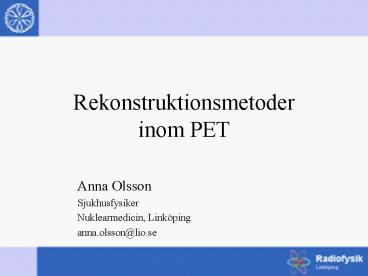Rekonstruktionsmetoder inom PET - PowerPoint PPT Presentation
1 / 37
Title:
Rekonstruktionsmetoder inom PET
Description:
Timothy Turkington, Ph.D. Department of Radiology, Duke University Medical ... Courtesy: Brian Hutton, UCL London. Regularisation. Regularisation (noise reduction) ... – PowerPoint PPT presentation
Number of Views:40
Avg rating:3.0/5.0
Title: Rekonstruktionsmetoder inom PET
1
Rekonstruktionsmetoder inom PET
- Anna Olsson
- Sjukhusfysiker
- Nuklearmedicin, Linköping
- anna.olsson_at_lio.se
2
Tomografiska Rekonstruktionsmetoder
- Analytiska (t.ex. FBP)
- Iterativa
- Algebraiska
- Statistiska
- Poisson (t.ex.. ML-EM)
- Least squares
3
Insamlingsdata 2D, 3D
- 3D ?2D (rebinnig)
- Fully 3D
- List mode
- Projektioner
- List mode
2D
3D
Timothy Turkington, Ph.D. Department of
Radiology, Duke University Medical Center,
Durham, North Carolina, USA
4
Insamling och Rekonstruktion
Data Acquisition
Reconstructed Image
Sinogram (raw data)
Timothy Turkington, Ph.D. Department of
Radiology, Duke University Medical Center,
Durham, North Carolina, USA
5
Analytiska metoder
6
2D FBP
Zeng GL, Comput. Med. Imag. Graph. 2597-103,
2001.
7
Convolution kernel
Kak AC, Slaney M, Principles of Computerized
Tomographic Imaging, 1988.
8
The Ramp filter
Kak AC, Slaney M, Principles of Computerized
Tomographic Imaging, 1988.
9
The Fourier slice theorem
Kak AC, Slaney M, Principles of Computerized
Tomographic Imaging, 1988.
10
Frequency domain mapping
Kak AC, Slaney M, Principles of Computerized
Tomographic Imaging, 1988.
11
The Ramp filter
Kak AC, Slaney M, Principles of Computerized
Tomographic Imaging, 1988.
12
Reconstruction filter
Bendriem B, Townsend DW, The theory and practice
of 3D PET, 1998.
13
2D filtered backprojection (2D-FBP)
- where p(?) projection data (2D), h1(?)
kernel (1D), f(?) image (2D), ?
projection angle, e?? unit vector
perpendicular to direction of projection,
? convolution operator.
14
Reconstruction demo
Zeng GL, Comput. Med. Imag. Graph. 2597-103,
2001.
15
3D filtered backprojection (3D-FBP)
- where p(?) projection data (4D), h2(?)
kernel (2D), f(?) image (3D), e?,? unit
vector in direction of projection, ?
convolution operator.
16
Missing data
17
3D FBP - The reprojectionalgorithm3DRP
Bendriem B, Townsend DW, The theory and
practice of 3D PET, 1998.
18
Rebinning 3D?2D projection data
z
z
3D Recon
2D Recon
19
Rebinning algorithms
Single slice rebinning
Fourier rebinning
20
Fourier rebinning
Defrise M et al., IEEE TMI 16145-158, 1997.
21
Iterativa metoder
22
Byggstenar
- Data model
- Image model
- Cost function
- Iterative algorithm
23
Byggstenar
- Data model
- Image model
- Cost function
- Iterative algorithm
24
Byggstenar
- Data model
- Image model
- Cost function
- Iterative algorithm
25
ML-EM Maximum likelihood expectation
maximization(Shepp Vardi 1982, Lange Carson
1984)
Uppmätta projektioner
BP av ( )
Normerad
Bild(k1)
Bild(k)
Projektioner av bilden(k)
Cost function poisson likelihood
Bra beskriven av Bruyant, JNM 2002
26
OS-EM Ordered Subset Expectation Maximization
(Hudson Larkin, IEEE TMI 1994)
ML-EM
OS-EM
Sn data subset
27
OSEM problem
- Subset imbalance
- Convergence problem
xn
xk
arg max f1(x)
x
arg max f2(x)
Fessler, IEEE MIC 2001
28
Rescaled block iterative EMML (RBI - EMML)
(Byrne, IEEE TIP 1996)
- Removes subset imbalance.
29
Row action maximum likelihood algorithm (RAMLA)
(Browne De Pierro, IEEE TMI 1996)
- where ?k is a relaxation parameter 0 lt ?k ?
1 k ? ? ? ?k ? 0 ? ?k ?
30
EM reconstruction
1 2
5
comparison with projections
10 15
20
50 100
150
comparison with actual object
Courtesy Brian Hutton, UCL London
31
Regularisation
- Regularisation (noise reduction)
- stop early
- stopping criteria based on statistical hypothesis
testing - filtering
- post-reconstruction or between-iterations
- penalised cost function
- Bayesian methods
- Bayesian methods
- maximum a posteriori (MAP) or penalised methods
- Penalty function
- quadratic, Huber, median
- Structural information
- avoid smoothing across anatomical boundaries
32
MAP
penalty function (quadratic)
- regularisation parameter (hyperparameter)
- Nj neighbourhood of voxel j
- ?l weight factors
Bra beskriven av Bruyant, JNM 2002
33
Penalty functions
Fessler, IEEE MIC 2001
34
Maximum a-posteriori (MAP)
Quadratic Huber
35
Iterative algorithms
- Advantages
- physical model of measurement
- Normalization (detector efficiency)
- Randoms (measured)
- Scatter (model)
- Attenuation (transmission scan)
- statistical model of measurement (Poisson)
- a priori information (non-negativity)
- structural information (from CT/MRI)
- incomplete data set (limited angle, truncation)
- Disadvantages
- complexity (modelling)
- computation time
- non-linearity f(ab) ? f(a) f(b)
- Result depends on statistics and activity
distribution!
36
Vad har vi lärt oss idag?
- 2D FBP
- 3D FBP
- MLEM
- OSEM
- RBI EMML
- RAMLA
- MAP
37
SLUT































